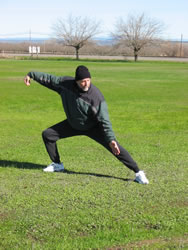Dear Michael:
"A friend of mine asked me to help translate Tai Chi 24 Forms
into Cantonese dialect. Your web page of 24 Forms was introduced to me for
reference. I am amazed at the number of translations for each movement.
I have come to realize the difficult task of getting to the
real essence of translation. Inappropriate or incompetent translation makes the
concepts ambiguous or misleading (with all the funny Chinese phrases of naming
things.) Though in all honesty, each source tries to fit the bill, rarely do
they come across the original design/intent of the moves in a comprehensive way.
Usually most Western sources just cannot read the Chinese
words, lesser still the Chinese way of thinking. The Chinese side usually don’t
know English well enough to get the essence across with poor diction.
But I must say that I am no expert. Only that I have observed
some errors, and thought I should mention it to contribute to common
understanding. I only do so as you welcome suggestions from others. (I am a
native Chinese speaker.)
Here are the
examples:
#3 白鵝亮翅 Word to word: White| Goose|
Flash| Wing
Most Tai Chi schools use White Crane Spreads Its Wings. If
this is the case, then the Chinese phrase should be白鶴亮翅. 鶴 = Crane.
白鶴亮翅 Bai
He Liang Chi [Mandarin]
——————————————————————————————
# 8 拦雀尾右 : Lan Que Wei You : Grasp the Bird's Tail Right
拦 means
‘To block’, not ‘grasp’. This I believe is a typo, as it has the same sound as 揽.
So is should be揽雀尾[右] Lan Que Wei (You) [Mandarin] (Notice
I put a bracket around the word右,RIGHT; for better illustration.)
——————————————————————————————
#16 下势 : Xia Shi : Snake (?) Creeps Down
下势 Word to word: Low|
Inertia, dynamic force, or tendency, etc.
There is no mentioning of any animal’s name. I would be
interested to know how this translation came about. Or, it is taken as an
English slang?
Ok, that is all. I am struggling with my own thinking on this
tough translation project. I admire your zest of life reflected in your web
pages.
All the best."Phil
**********************************
Phil,
I have often been perplexed about the translations or interpolations of the "names" of the movements in various Taijiquan forms. The reference sources I have studied vary somewhat.
I'm sure that a Cantonese vs a Mandarin starting point would reveal different results. Then, again, an English, Spanish, or French version would provide additional interesting interpolations.
As for my qualifications, I am fluent in only in the English language. The only other language I use in my daily life is Spanish.
Considering the worldwide popularity of the Standard Simplified 24 T'ai Chi Ch'uan 1956 form, I thought that some effort should be made to show the range of given names for each of the movement forms in the 24 Form, and I tried to do so on my Taijiquan 24 Form webpage.
I welcome your comments and suggestions. I would be willing to integrate them into my webpage if you send them to me, link to your webpage on the subject, or publish your final document as a separate webpage.
Best Wishes,
Mike Garofalo

The comments are interesting, but even with the correct animal - a white goose instead of a white crane - there appears to be a layer of meaning beyond literal translation. What attributes does one bird get associated with over the other? And, even when the name is the same, different forms and styles will do markedly different variations. Some individual forms will give the same name to physically different movements, some movements look very similar but have a different name ie Retreat to Ride the Tiger. Does a background in the Chinese language really help to clarify this?
ReplyDeleteJohn, you are helping to outline a solution to achieve clarification by discussing the topic.
ReplyDeleteMy own interpretation is that we are playfully dealing with names, enjoying the sounds of the words, favoring aesthetic flourishes with the language, embracing metaphor as if It was a Goddess - Metaphor. Poetry for fun, delight, and insight. And, when you layer on the complexity of Chinese-English translation, the edges of visualizations, fictional works, history ... bewildering but pleasuable games like Waving Hands like Clouds (Yun Shou), Pick Up the Needle from the Bottom of the Sea, Golden Rooster Stands on One Leg, Lazily Tying One's Coat, Six Sealing and Four Closing ... I feel a poem coming on. Taiji poetry. Qigong poetry.
Let the words flow, brother!
Mike Garofalo